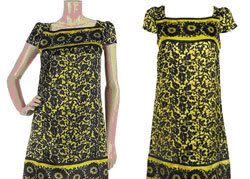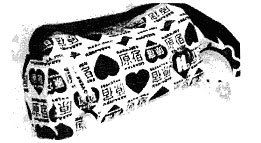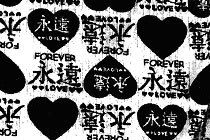Stricter Copyright Rules for Fashion: A Faux Pas
by: Amy Duvall, Associate Editor, MTTLR

DVF Cerisier Dress vs. Forever 21 Silk Sabrina Dress7
1 The Trademark Blog, http://www.schwimmerlegal.com/2007/09/19_lawsuits_aga.html (Sept. 17, 2007, 11:02 EST).
2 15 U.S.C. 1125(a).
3 Complaint, Harajuku Lovers, LLC v. Forever 21, Inc., No. CV-07-3881-ODW (SSX) (C.D. Cal. filed June 14, 2007), available at http://images.eonline.com/static/news/pdf/gwen_stefani_forever21_lawsuit.pdf.
4 Danica Lo, Designer Sues: ‘Evil’ Twin von Furious at ‘Copycat’, NEW YORK POST, Mar. 29, 2007, available at http://www.nypost.com/seven/03292007/news/regionalnews/designer_sues_regionalnews_danica_lo.htm.
5 Id.
6 Settlement, Diane von Furstenberg Studio, LP. v. Forever 21, Inc., 07 Civ. 2413 (VM) (S.D.N.Y. Sept. 7, 2007), available at http://www.counterfeitchic.com/Cases/cic/3/dvf_forever_settle.pdf.
7 Posting of retrogurl to nitro:licious, http://www.nitrolicious.com/blog/2007/03/28/diane-von-furstenberg-sues-forever-21/ (Mar. 28, 2007).
8 See Complaint, Anna Sui Corp. v. Forever 21 Inc., No. 07 CV 3235 (S.D.N.Y. filed Apr. 23, 2007), available at http://counterfeitchic.com/Cases/sui.pdf (Oct. 13, 2007).
9 Eric Wilson, Along Various Roads, Including the Yellow Brick, N.Y. TIMES, Sept. 13, 2007, available at http://www.nytimes.com/2007/09/13/fashion/shows/13REVIEW2.html.
10 Lynn Yaeger, Sui Generis?: Anna Sui, others sue Forever 21: How original are you?, THE VILLAGE VOICE, Sept. 25, 2007, available at http://www.villagevoice.com/nyclife/0739,yaeger,77905,15.html.
11 Id.
12 Design Piracy Prohibition Act, S. 1957, 110th Cong. (2007).
13 Design Piracy Prohibition Act, H.R. 2033, 110th Cong. (2007).
14 Am. Safety Table Co. v. Schreiber, 269 F.2d 255, 272 (2d Cir. 1959).
15 Kal Raustiala and Christopher Sprigman, How Copyright Law Could Kill the Fashion Industry, THE NEW REPUBLIC, Aug. 14, 2007, available at http://www.tnr.com/doc.mhtml?i=w070813&s=raustialasprigman081407.
16 Whimsicality, Inc. v. Rubie’s Costume Co., 891 F.2d 452, 544 (2d Cir. 1989).
17 Kieselstein-Cord v. Accessories by Pearl, Inc., 632 F.2d 989 (2d Cir. 1980).
It has been a tough year for Forever 21. Over the past year, the down-market fashion merchandiser has been hit by several lawsuits (19 as of September, according to The Trademark Blog).1 The issue is whether Forever 21’s “borrowing” from the lines of fashion designers crosses the line into copyright violation.
In June 2007, Gwen Stefani filed a complaint in District Court, alleging false designation of origin2, and common law trademark infringement against Forever 21 for allegedly copying her heart design trademark. Stefani alleges that Forever 21 infringed upon her “Harajuku Lovers” design, rendering the two “virtually indistinguishable”. She is seeking injunctive relief and damages from the profits that Forever 21 has earned from the alleged infringement of her design.3
In June 2007, Gwen Stefani filed a complaint in District Court, alleging false designation of origin2, and common law trademark infringement against Forever 21 for allegedly copying her heart design trademark. Stefani alleges that Forever 21 infringed upon her “Harajuku Lovers” design, rendering the two “virtually indistinguishable”. She is seeking injunctive relief and damages from the profits that Forever 21 has earned from the alleged infringement of her design.3
 |  |  |
Designer Diane von Furstenberg also sued Forever 21 for copyright infringement, claiming that the retailer copied one of her popular dresses down to the pattern, colors, and cut. Both dresses are silk and made in China. “The difference in prices [$32 versus $325] likely has something to do with the premium put on the designer eye, product development on the part of von Furstenberg, the manufacturing conditions and the quality of the material.”4
While popular clothing designs have been knocked off and sold on street corners for decades, von Furstenberg’s attorneys claim that “the harm done [here] is probably greater. Consumers are more likely to think they’re buying the real thing at a retail outlet like this one, as opposed to a street corner. When the quality isn’t there, as it ultimately isn’t, the consumers blame the brand.”5 The two parties settled out of court on September 6, 2007 for an undisclosed amount.6
While popular clothing designs have been knocked off and sold on street corners for decades, von Furstenberg’s attorneys claim that “the harm done [here] is probably greater. Consumers are more likely to think they’re buying the real thing at a retail outlet like this one, as opposed to a street corner. When the quality isn’t there, as it ultimately isn’t, the consumers blame the brand.”5 The two parties settled out of court on September 6, 2007 for an undisclosed amount.6

DVF Cerisier Dress vs. Forever 21 Silk Sabrina Dress7
Anna Sui has not just sued Forever 218, she has fought back, creating t-shirts depicting Forever 21’s founders Don and Jin Chang on “wanted” posters.9 However, this suit is ironic given that she has made a career out of “resuscitating, revamping, and rethinking the vintage fashions of the 1960s and ‘70s, the decades when she was young.”10

Elena Dahl models the "Forever WANTED" T-Shirt
Mollye Chudacoff11
High fashion designers are not just fighting back against Forever 21 and other imitator retailers – they have gone to Congress as well. Legislation is currently pending in both the House and the Senate to provide greater copyright protection for fashion designs. In the Senate, a bill sponsored by Charles Schumer (D. New York) would extend copyright protection to cover fashion designs.12 While the current U.S. copyright law protects labels, logos, and distinctive embellishments, this bill would cover the whole “look” of an article of clothing – meaning pattern, color, and cut would now be protected. The House has similar legislation pending (sponsored by Bill Delahunt (D-Mass)).13
While it is understandable that designers are angry that down-market copycats like Forever 21 appear to be copying their designs, their actions, in the form of lawsuits, are not necessarily in the best long-term interests of the high fashion industry. In contrast to the more stringent intellectual property protection for music, film, or literature, the courts have held that, for fashion, “imitation is the life blood of competition.”14 Imitation is essential to the fashion industry in creating trends – “every season we see fashion firms ‘taking inspiration’ from others’ designs. And every season we see trends catch on and have a moment of wide appeal, only soon to become overexposed and die.”15
Another problem with copyrighting fashion is that many judges consider clothing to be a “useful article ... useful articles standing alone may never be [copyrighted].”16 However, if a part of clothing can be considered “conceptually separate” from their subsidiary utilitarian function, the “conceptually separate part of the clothing may be copyrighted. For example, an ornamental belt buckle is copyrightable, but the belt itself is not.17
While some high fashion designers claim that they are losing profits due to imitators like Forever 21, any lost profits are probably more due to economic downturns than down-market competition. The markets for designer merchandise and imitation merchandise are distinct, with very little overlap. Despite von Furstenberg’s claim that her designs had been stolen, the alleged theft is unlikely to have cost her money, as it is unlikely that a woman who can afford to buy von Furstenberg’s original would choose to buy the lower-quality Forever 21 version instead.
Rather than suing imitators, high fashion designers would be better off ignoring them. Stores like Forever 21 may actually enhance the prestige of and desire for the original high fashion brand. For many women, owning their first Coach or Kate Spade purse is a fashion milestone. Later in life, these same women who bought the down-market imitation of the Diane von Furstenberg “it” dress will buy the real thing, once they have the financial wherewithal to do so.
By limiting the ability of companies like Forever 21 to imitate runway trends, fashion designers are cutting off an important gateway for women (and some men) to know and begin to covet their brands. As any fashionista knows, there is a world of difference between the imitation and the real thing. Many women will not buy the store-brand version when they can buy the original instead.

Elena Dahl models the "Forever WANTED" T-Shirt
Mollye Chudacoff11
High fashion designers are not just fighting back against Forever 21 and other imitator retailers – they have gone to Congress as well. Legislation is currently pending in both the House and the Senate to provide greater copyright protection for fashion designs. In the Senate, a bill sponsored by Charles Schumer (D. New York) would extend copyright protection to cover fashion designs.12 While the current U.S. copyright law protects labels, logos, and distinctive embellishments, this bill would cover the whole “look” of an article of clothing – meaning pattern, color, and cut would now be protected. The House has similar legislation pending (sponsored by Bill Delahunt (D-Mass)).13
While it is understandable that designers are angry that down-market copycats like Forever 21 appear to be copying their designs, their actions, in the form of lawsuits, are not necessarily in the best long-term interests of the high fashion industry. In contrast to the more stringent intellectual property protection for music, film, or literature, the courts have held that, for fashion, “imitation is the life blood of competition.”14 Imitation is essential to the fashion industry in creating trends – “every season we see fashion firms ‘taking inspiration’ from others’ designs. And every season we see trends catch on and have a moment of wide appeal, only soon to become overexposed and die.”15
Another problem with copyrighting fashion is that many judges consider clothing to be a “useful article ... useful articles standing alone may never be [copyrighted].”16 However, if a part of clothing can be considered “conceptually separate” from their subsidiary utilitarian function, the “conceptually separate part of the clothing may be copyrighted. For example, an ornamental belt buckle is copyrightable, but the belt itself is not.17
While some high fashion designers claim that they are losing profits due to imitators like Forever 21, any lost profits are probably more due to economic downturns than down-market competition. The markets for designer merchandise and imitation merchandise are distinct, with very little overlap. Despite von Furstenberg’s claim that her designs had been stolen, the alleged theft is unlikely to have cost her money, as it is unlikely that a woman who can afford to buy von Furstenberg’s original would choose to buy the lower-quality Forever 21 version instead.
Rather than suing imitators, high fashion designers would be better off ignoring them. Stores like Forever 21 may actually enhance the prestige of and desire for the original high fashion brand. For many women, owning their first Coach or Kate Spade purse is a fashion milestone. Later in life, these same women who bought the down-market imitation of the Diane von Furstenberg “it” dress will buy the real thing, once they have the financial wherewithal to do so.
By limiting the ability of companies like Forever 21 to imitate runway trends, fashion designers are cutting off an important gateway for women (and some men) to know and begin to covet their brands. As any fashionista knows, there is a world of difference between the imitation and the real thing. Many women will not buy the store-brand version when they can buy the original instead.
1 The Trademark Blog, http://www.schwimmerlegal.com/2007/09/19_lawsuits_aga.html (Sept. 17, 2007, 11:02 EST).
2 15 U.S.C. 1125(a).
3 Complaint, Harajuku Lovers, LLC v. Forever 21, Inc., No. CV-07-3881-ODW (SSX) (C.D. Cal. filed June 14, 2007), available at http://images.eonline.com/static/news/pdf/gwen_stefani_forever21_lawsuit.pdf.
4 Danica Lo, Designer Sues: ‘Evil’ Twin von Furious at ‘Copycat’, NEW YORK POST, Mar. 29, 2007, available at http://www.nypost.com/seven/03292007/news/regionalnews/designer_sues_regionalnews_danica_lo.htm.
5 Id.
6 Settlement, Diane von Furstenberg Studio, LP. v. Forever 21, Inc., 07 Civ. 2413 (VM) (S.D.N.Y. Sept. 7, 2007), available at http://www.counterfeitchic.com/Cases/cic/3/dvf_forever_settle.pdf.
7 Posting of retrogurl to nitro:licious, http://www.nitrolicious.com/blog/2007/03/28/diane-von-furstenberg-sues-forever-21/ (Mar. 28, 2007).
8 See Complaint, Anna Sui Corp. v. Forever 21 Inc., No. 07 CV 3235 (S.D.N.Y. filed Apr. 23, 2007), available at http://counterfeitchic.com/Cases/sui.pdf (Oct. 13, 2007).
9 Eric Wilson, Along Various Roads, Including the Yellow Brick, N.Y. TIMES, Sept. 13, 2007, available at http://www.nytimes.com/2007/09/13/fashion/shows/13REVIEW2.html.
10 Lynn Yaeger, Sui Generis?: Anna Sui, others sue Forever 21: How original are you?, THE VILLAGE VOICE, Sept. 25, 2007, available at http://www.villagevoice.com/nyclife/0739,yaeger,77905,15.html.
11 Id.
12 Design Piracy Prohibition Act, S. 1957, 110th Cong. (2007).
13 Design Piracy Prohibition Act, H.R. 2033, 110th Cong. (2007).
14 Am. Safety Table Co. v. Schreiber, 269 F.2d 255, 272 (2d Cir. 1959).
15 Kal Raustiala and Christopher Sprigman, How Copyright Law Could Kill the Fashion Industry, THE NEW REPUBLIC, Aug. 14, 2007, available at http://www.tnr.com/doc.mhtml?i=w070813&s=raustialasprigman081407.
16 Whimsicality, Inc. v. Rubie’s Costume Co., 891 F.2d 452, 544 (2d Cir. 1989).
17 Kieselstein-Cord v. Accessories by Pearl, Inc., 632 F.2d 989 (2d Cir. 1980).





2 Comments:
You argue that knock-offs will "enhance the prestige of and desire for the original high fashion brand." Even if this is overstated, I at least agree that knock-offs don't decrease the prestige of and desire for the original brand.
The arguments in favor of copyright protection aren't new, though. In 1997, for instance, a law student named Jennifer Mencken argued:
"Fashion designers have always been known for their quality of design, materials and construction. In the race to compete with the design pirates, the apparel industry has continually eliminated these elements." link at footnote 138.
If Mencken is right that knock-offs decrease "quality of design, materials and construction," copyright protection seems like a fairly logical way to resolve the problem. In addition, it seems that any policy argument against copyright protection needs to address the question of decreased quality.
Do you think Mencken is just factually wrong, or do you think she may be right but that, from a policy standpoint, it doesn't matter?
The topic as you presented had many interesting points and was well thought and written. However, I do not believe that clothing should be copyrighted for a couple of reasons. Our court system is already overburdened with legal matters. The cost of a lawsuit, regardless of whether it’s legitimate or not, is so expensive it would put new designers out of business. To avoid competition, wealthy houses would just keep upstart design houses in the court system. The second problem I see is there would then be a need to copyright fabrics. Fabric houses sell the same patterns to many designers and the designer doesn’t necessarily own the fabric. This is the reason the two dresses in your blog look identical. As the Wall Street Journal pointed out in the article, “Check out the new threads,” Italian manufactures have solved this copycat syndrome by commissioning small runs of high-tech new fabrics. These fabrics are too expensive and exclusive for cheap retailers to knock off. In addition to coming up with exclusive designs, there are new blends of synthetic fabrics that contain rubber and nylon with natural fibers. The new fiber combinations drape differently allowing new shapes in clothing that are difficult to replicate. In response to the designer complaint regarding lost sale due to cheap replicas, honestly a Forever 21 customer is not going to buy a Diane Von Furstenberg dress anyway. High-end designer clothing is about creativity and new design. Let’s find creative ways to solve this problem and stay out of the legal system.
Post a Comment
Subscribe to Post Comments [Atom]
<< Home